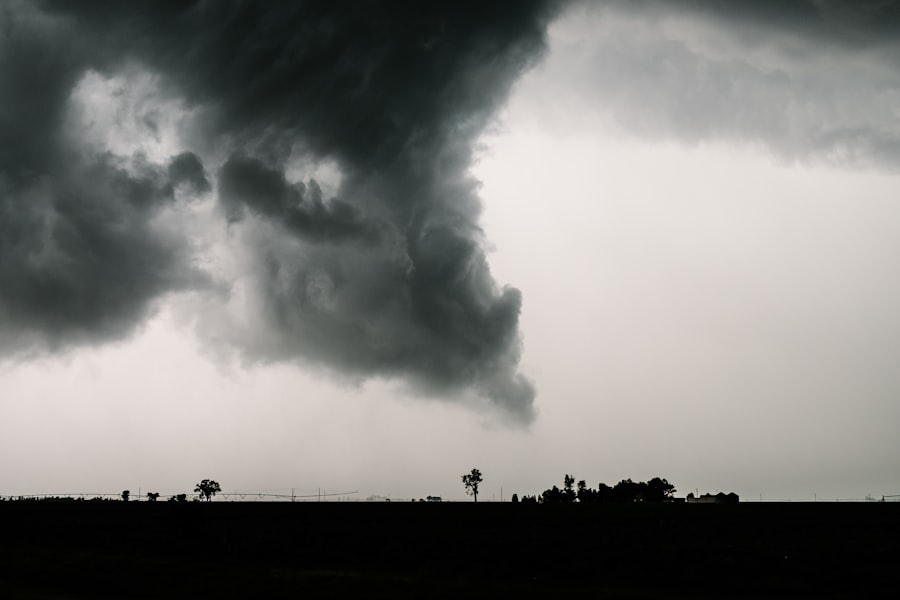Tornadoes are among nature’s most violent phenomena, capable of causing devastating destruction in mere minutes. As I delve into the science behind these swirling columns of air, I find it fascinating yet terrifying how they form. Tornadoes typically develop from severe thunderstorms, particularly supercells, where warm, moist air at the surface meets cooler, drier air aloft.
The sheer power of a tornado is measured on the Enhanced Fujita Scale, which ranges from EF0, indicating minimal damage, to EF5, which can obliterate entire neighborhoods. Understanding these classifications helps me grasp the potential risks associated with tornadoes and the importance of preparedness.
The risks posed by tornadoes extend beyond the immediate destruction they cause. The aftermath can be equally perilous, with debris scattered across landscapes, downed power lines, and disrupted infrastructure. I often think about how quickly lives can change; one moment everything is normal, and the next, a tornado can uproot homes and shatter communities.
Additionally, tornadoes can occur with little warning, making it crucial for me to stay vigilant during peak tornado seasons. The unpredictability of their paths and intensity adds to the anxiety many feel when severe weather looms. By understanding these risks, I can better prepare myself and my loved ones for the possibility of encountering a tornado.
Creating a Tornado Emergency Plan
Safety First: Identifying Safe Locations
Ideally, these safe locations would be a basement or an interior room on the lowest floor, away from windows. I make sure everyone in my household knows these designated safe spots and practices going there quickly. Regular drills help reinforce this knowledge, ensuring that when the time comes, we can act swiftly and without panic.
Staying Connected: Communication Strategies
In addition to identifying safe locations, I also consider communication strategies in my emergency plan. I establish a method for staying in touch with family members if we are separated when a tornado strikes. This might involve designating a specific meeting point outside our home or using mobile phones to communicate if possible.
Staying Informed and Empowered
I also make it a point to stay informed about local weather conditions through reliable sources such as weather apps or local news stations. By having a comprehensive emergency plan in place, I feel more empowered and less anxious about the potential for tornadoes.
Building a Tornado Emergency Kit

As I prepare for the possibility of a tornado, assembling an emergency kit becomes a priority. This kit serves as a lifeline during and after a storm, providing essential supplies that can sustain me and my family until help arrives or we can return to normalcy. I start by gathering basic necessities such as water, non-perishable food items, and a first aid kit.
It’s crucial to have enough supplies to last at least 72 hours since access to resources may be limited immediately following a tornado. In addition to food and water, I include important documents in my emergency kit. This includes copies of identification, insurance policies, and medical records stored in a waterproof container.
I also think about including items that cater to specific needs within my household, such as medications or supplies for infants or pets. A flashlight with extra batteries is another essential item; power outages are common after severe storms, and having light can make navigating through dark spaces much safer. By taking the time to build a well-rounded emergency kit, I feel more secure knowing that I have the tools necessary to face whatever challenges may arise.
Securing Your Home Against Tornadoes
| Securing Your Home Against Tornadoes |
|---|
| 1. Install impact-resistant windows and doors |
| 2. Reinforce garage doors |
| 3. Secure outdoor furniture and equipment |
| 4. Trim trees and remove dead branches |
| 5. Install a safe room or storm shelter |
| 6. Strengthen the roof with hurricane straps |
| 7. Anchor the house to the foundation |
Securing my home against tornadoes is another critical aspect of preparedness that I take seriously. While no structure can be entirely tornado-proof, there are several measures I can implement to minimize damage and enhance safety. One of the first steps I take is to assess my roof and ensure it is in good condition.
Loose shingles or structural weaknesses can make my home more vulnerable to wind damage. Reinforcing the roof with hurricane straps or clips can provide additional support against strong winds. I also focus on securing outdoor items that could become dangerous projectiles during a tornado.
Lawn furniture, garden tools, and other loose objects should be stored indoors or anchored down to prevent them from being swept away by high winds. Additionally, I consider installing storm shutters or impact-resistant windows to protect against flying debris. These measures not only help safeguard my property but also contribute to the overall safety of my family during severe weather events.
Staying Informed During Tornado Season
Staying informed during tornado season is vital for my safety and preparedness efforts. I make it a habit to monitor local weather forecasts regularly, especially during spring and early summer when tornado activity peaks in many regions. Utilizing weather apps on my smartphone allows me to receive real-time alerts about severe weather warnings in my area.
These notifications are crucial for ensuring that I am aware of any impending threats and can take appropriate action. In addition to technology, I also pay attention to community resources such as NOAA Weather Radio broadcasts. These radios provide continuous updates on weather conditions and emergency alerts directly from the National Weather Service.
By having multiple sources of information at my disposal, I feel more equipped to respond quickly if a tornado warning is issued. Staying informed not only helps me protect myself but also allows me to assist neighbors or friends who may not have access to timely updates.
Knowing Where to Seek Shelter

Safety at Home
In my home, I have identified the safest areas—typically an interior room on the lowest floor or a basement—where we can take cover during a tornado warning.
Preparedness on the Go
However, it’s not just about knowing where to go within my home; I also consider what to do if I am away from home when a tornado strikes. Familiarizing myself with nearby public shelters is crucial for situations where I may not be able to return home quickly enough.
Public Shelters as a Safe Haven
Local schools or community centers often serve as designated shelters during severe weather events. By knowing these locations ahead of time, I can act decisively if I find myself caught in a storm while out and about.
Preparing Your Pets for Tornadoes
As much as I prioritize my own safety during tornadoes, I cannot forget about my pets. Preparing them for severe weather is just as important as preparing myself and my family. One of the first steps I take is ensuring that my pets are microchipped or have identification tags with up-to-date contact information.
In the chaos following a tornado, pets can easily become lost or separated from their owners; having proper identification increases the chances of being reunited. I also create an emergency plan specifically for my pets that includes their designated safe space during storms. Just like with humans, it’s essential for pets to have a secure area where they can feel safe during turbulent weather.
Additionally, I assemble an emergency kit for them that includes food, water, medications, leashes, and any comfort items they may need during stressful situations. By taking these precautions for my pets, I ensure that they are protected and cared for during tornado events.
After the Tornado: Recovery and Safety Measures
The aftermath of a tornado can be overwhelming; once the storm has passed, the focus shifts from survival to recovery. Assessing damage safely is one of the first steps I take after ensuring that everyone in my household is accounted for and unharmed. It’s crucial to avoid entering damaged buildings until they have been deemed safe by professionals; structural integrity may be compromised, posing additional risks.
In addition to assessing damage, I also consider how to access resources for recovery efforts. Local authorities often provide information on disaster relief services available in the aftermath of severe weather events. This may include assistance with temporary housing or financial aid for those affected by the storm’s destruction.
Connecting with neighbors and community organizations can also foster support networks that help facilitate recovery efforts. As I reflect on the entire process—from understanding tornadoes and their risks to preparing for their impact—I realize that being proactive is key to minimizing fear and uncertainty during severe weather events. By taking these steps seriously and remaining vigilant throughout tornado season, I empower myself and those around me to face nature’s challenges with resilience and preparedness.
When creating a tornado preparedness checklist, it is important to understand how tornadoes form and the regions most at risk, such as Tornado Alley. To learn more about how tornadoes form, check out this informative article here. Understanding the science behind tornadoes can help individuals better prepare for these destructive storms.

